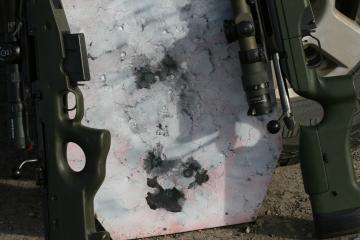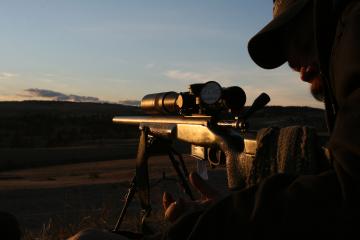
 These two rifles shoot into one hole at 100 yards - a little better than 0.5 MOA - and that
translates to three or four-inch groups at 940 yards.
Rifle Selection Criteria
In order to make long-range hits, the rifle itself has to do several things:
Accuracy. It has to have sufficient mechanical accuracy. For the purposes of practical
long-range shooting as discussed in this article, 1 MOA is sufficient. This is sufficient to hit
a 10" circle at 1000 yards, or an IPSC silhouette target's "head" (6x6") at 600 yards. Obviously
more accuracy is always better, and a half-MOA rifle is preferable to a 1 MOA rifle. In most
cases, the error in wind estimation and subsequent wind changes will subsume the difference
between a 1/4 MOA and 1 MOA rifle (at least for windage error). Most of the accuracy comes from
a good barrel.
Long-range accuracy depends on external trajectory just as much as 100-yard "mechanical"
accuracy, so velocity is important. Everything else equal, a longer barrel will give more
velocity and be better at making long-range hits. For a rifle intended to make 1000-yard shots,
I recommend at least 24" barrel length for short-action calibers such as 308 or 260. Going to
26" is even better. For the magnum or long-action calibers like 300WM, 7RM, 6.5-284, or 338
Lapua, a 26-28" barrel will be a better choice, and it will yield more gain in those additional
inches than you would see in the smaller calibers.

 This Surgeon rifle chambered in .260 Remington was designed specifically to fit shooter Chuck Ward and his requirements.
Ergonomics. The rifle has to fit the shooter, accommodating a comfortable and stress-free
position while shooting from various common positions. Stock setup and scope positioning are
critical for proper eye relief for full field of view through the scope. When these are set
right, the shooter can get on the gun and obtain a fire-able sight-picture without muscle strain.
The other related adjustment is the length of pull, from butt-stock to trigger. The best way to
make sure the ergonomics of the rifle will fit you is to get an adjustable stock. It should be
adjustable for length (typically add pads or shims on the buttstock) and it should have an
adjustable-height cheek comb. The McMillan A-5, and the Accuracy International AICS stocks are
both excellent choices.
Controls. The controls required to operate and shoot the rifle should be easy to actuate. The
most important two controls are the trigger and, for a bolt-action rifle, the bolt. The trigger
can be of a single-stage or two-stage design, based on shooter preference, and should break at
2-4 lbs. The bolt should be able to be operated to cycle the action without the shooter having
to move from his shooting position. The sight picture should be retained through the bolt cycle.
The safety needs to be operable and reasonably easy to switch. A bipod, if used, should be easy
to deploy and stow, for quick setup at a shooting position.
Magazine. Most conventional bolt-action rifles have a blind magazine which loaded one round
at a time from the top. This is OK for shooting single rounds one after another when there is
little or no time pressure, and you have some way to carry the extra rounds. For the last 25
years, many issued sniper rifles have used detachable box magazines (DBM), similar to magazines
for the AR-15 or M14. These can be an asset to a practical long-range rifle when the shooter must
engage multiple targets quickly, or wants to be able to send follow-up shots with minimal delay.
They also facilitate unloading the rifle more quickly.
The best DBM system for bolt-action rifles right now comprises the Accuracy International
magazines for short or long-action calibers, in either an AICS stock or a Remington-700-series
stock (when fitted with the Badger "bottom metal" AICS magazine adapter). Both the SAKO and AI
factory rifles come with DBM systems already, and need no conversion. The H.S. Precision DBM
system has proved unreliable and I recommend avoiding it.
|